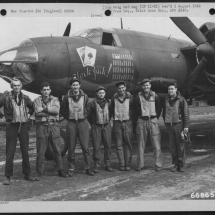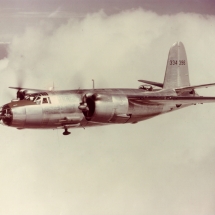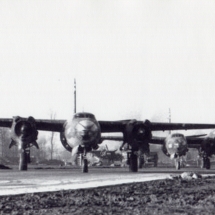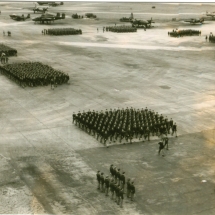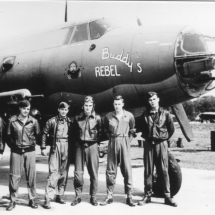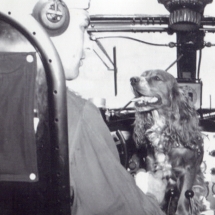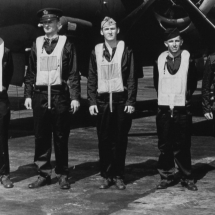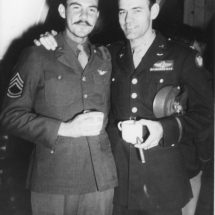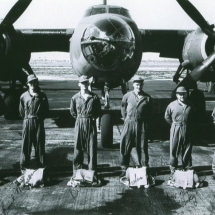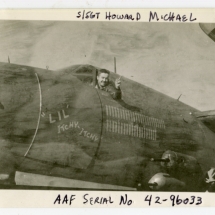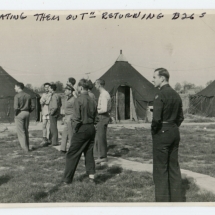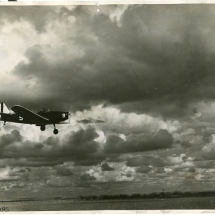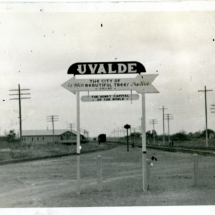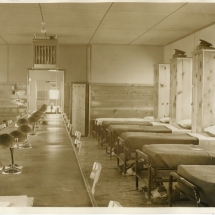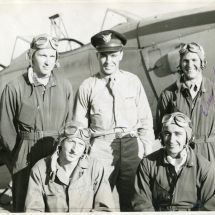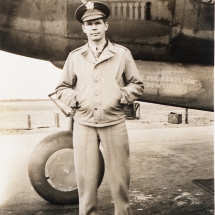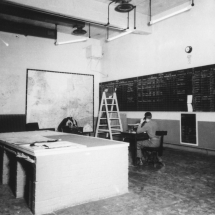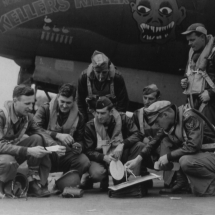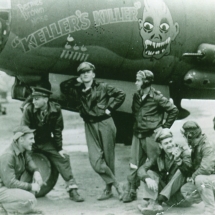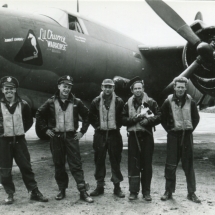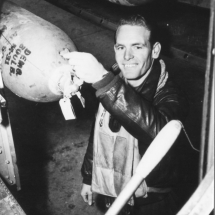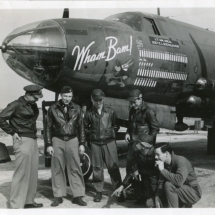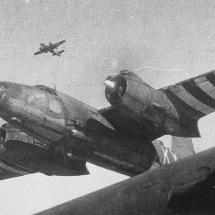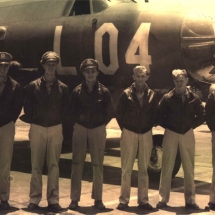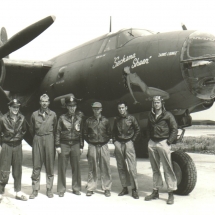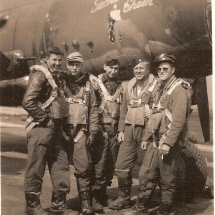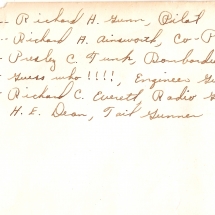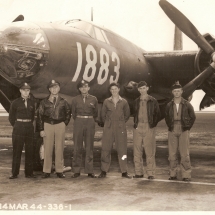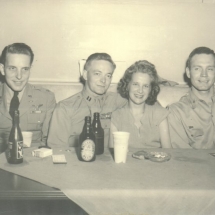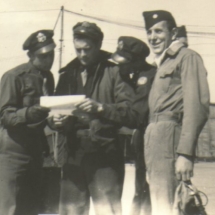From Alan Crouchman: “I have the 387th as using 187 aircraft on combat missions with the 558th using 54 of them. When the Group arrived in June 1943 each squadron had 16 crews each, this was soon increased to 18 per squadron around about Oct 1943. This may have been further increased later in the War but I do not have any specific figures.
Numbers of personnel assigned was a moving figure month by month, a selection of confirmed numbers is as below:
558th Bomb Squadron
June 43 73 officers 296 enlisted men
Jan 44 92 officers 342 enlisted men
Apr 44 88 officers 342 enlisted men
June 44 92 officers 356 enlisted men
Aug 44 85 officers 369 enlisted men
Dec 44 102 officers 360 enlisted men
Apr 45 105 officers 350 enlisted men
May 45 123 officers 387 enlisted men
Entire Group:
July 43 312 officers 1223 enlisted men
Aug 43 367 officers 1287 enlisted men
Feb 45 442 officers 1409 enlisted men
Apr 45 477 officers 1462 enlisted men
May 45 531 officers 1594 enlisted men
June 45 713 officers 1835 enlisted men
A large influx was experienced at the end of the war as various Groups were disbanded and personnel moved around between Groups.
Headquarters 387th:
Aug 43 27 officers 39 enlisted men
Feb 44 37 officers 55 enlisted men
June 44 38 officers 58 enlisted men
Sept 44 41 officers 60 enlisted men
Dec 44 43 officers 57 enlisted men
Apr 45 42 officers 62 enlisted men.
From the above figures you can take a mean average to give an idea of the full strength at any one time.” Alan Crouchman, 387th Historian
The Martin B-26 Marauder was designed to meet a demanding US Army Air Corps specification of 1939 for a high speed medium bomber. The Martin Model 179 proposal was considered to be so far in advance of competing submissions that in September 1939 the company was awarded an ‘off the drawing board’ contract for 201 of these aircraft. This action, unprecedented in USAAC history; required no prototype or preproduction aircraft, and the first production B-26, as the type was designated, was flown initially on November 1940. Issued initially to the 22nd Bomb Group at Langley Field, Virginia it fell to their crews to sort out the initial problems that came to light.
HEADQUARTERS 387 TH BOMBARDMENT GROUP / M
Narrative of events from 1 December 1942 to arrival the UK by William. B. Engler Major Aircorps Group Historian.
(Official Government records transcribed with no corrections by Richard Kunne, Holland, November 2002)
On 1 December 1942, Headquarters MacDill Field issued General Order # 97 at Tampa Florida and thus brought into being the Headquarters 387th Bombardment Group (M) and four member Squadrons of the Group, the 556th, 557th, 558th and 559th Bombardment Squadrons (M). The flow of personnel into the new organization started the next day, 2 December 1942, when the original cadre of 2 officers and 5 enlisted men joined from Miami Beach, Florida and Daniel Field, Georgia. By the end of December the strength was up to 10 officers and 4 enlisted men with Major David. S. Blackwell in command of the Group.
In January of 1943 the headquarters expanded to 21 officers and 32 enlisted men, and the job of welding the personnel into a single weapon was started. On 19 January 1943, Colonel Carl. R. Storrie was assigned from HQ. & HQ.SQ III Bomber Command and took command of the Group. On 22 January Lt. Col. Stillman, Group Executive Officer and Major Samuel. L. Croswait, Group Adjudant joined the Group. Major Blackwell, who was relieved of command when Col. Storrie was assigned, was Group Executive Officer until Lt. Col. Stillman’s assignment. At that time Major Blackwell, who had seen the Group through it’s creation and initial organization was transferred to the just then created 391st Bombardment Group (M) at his own request. A very able and extremely popular officer, major Blackwell was missed by all the Headquarters personnel who had known and worked with him.
At the end of February 1942 the records of HQ showed a decreasing increasing in strength with 25 officers and 38 enlisted men assigned which meant the rapid expansion period was over. It also meant the next step – training for combat duties was about to begin and for the majority of the men it was welcome. The greater part of the personnel had been recruited from O.T.U. and R.T.U. organizations and the continual sameness of training and garrison had been boring. However now we were formed into a combat group and were ready to “ Learn How “.
The only building MacDill Field could offer the organization for the Group HQ. was a temporary 2 story building, a barracks. Even at that only the ground floor was offered since the second floor was still in use as a barracks. Luckily, in January, other quarters were found for the HQ in the form of a building with no enlisted men sleeping on the second floor in fact, with no second floor.
The final details of the 1st phase were completed by February and on that date the entire Group met in the base Theatre at Col. Storrie’s summons. The meeting was later dubbed “The hat in the ring session” because Col. Storrie opened by throwing his hat in the “ring” for the 387th Bomb.Gp. and invited all those unwilling to work and fight on the team, he proposed building to request transfer. The proposition considered and agreed to, the vote to stay was unanimous. After Col. Storrie had finished his pertinent remarks on aims, policies and procedure the leading officers and enlisted men were introduced to the Group. Some 1.600 men walked into the MacDill Theatre at 10.00 A.M. 2 February 1943 and at 11.15 A.M. the 387th Bomb Group walked out of it.
On 8 February 1943 the group moved into Hangar #4 at MacDill and 2nd phase was begun in compliance with training directives, familiarization with new duties and new equipment.
On February 9 Major Thomas. M. Seymour, listed as Group Operations Officer, joined from Barksdale Field, LA. , and completed the Group HQ Staff which read as follows:
Col. Carl. R. Storrie, Commanding
Lt. Col. Robert. M. Stillman, Group Executive Officer
Major Samuel. L. Crosthwait, Group Adjutant
Captain John. M. Campbell, Group S-2
Major Thomas. M. Seymour, Group S-3
Captain Marvin. M. Harvey, Group S-4
The other officers at HQ at this time were :
Captain James. L. Moffett, Group Surgeon
1st Lt. William Faulds, Chaplain
2nd Lt. Oliver J. Blanchard, Special services Officer
1st Lt. Robert Thackwell, Ass’t S-1
2nd Lt. Franklyn L. lowenthal, Ass’t S-2
1st Lt. H.T. Watson, Ass’t S-3
1st Lt. Gayle L. Smith, Ass’t S-3
2nd Lt. Joe M. Hassler, Ass’t S-4
1st Lt. Harry A. Garvey, Group Communications officer
2nd Lt. Harry S. Dennis, Group Bombardier
2nd Lt. Meinke, Group Navigator
2nd Lt. Ed J. Markowski, Athletic Officer
2nd Lt. Thomas H. Guthrie, Photo Interpreter
2nd Lt. Robert M. Culp, Statistical Officer
In March the strength was 22 officers and 39 enlisted men and the Group was hard at work planning and executing “missions”, operating Ground school for combat crews, and generally getting in shape to be able to move quickly and fight efficiently. On March 18 the Group lost another of it’s officers, Lt. Col. Stillman whose bright outlook and enormous capacity for work had made him one of the most valuable members of the Group. Evidently Col. Stillman’s worth was appreciated by the “higher ups” for on the 18th, he left the 387th to take command of the 322nd bomb.Gp. at that time the Air Echelon of the 322nd was in England and the Ground Echelon in America. Col. Stillman flew to England to take command, and it was from there the fatal mission to Ijmuiden on May 18th which was to cost so much in men, aircraft and hopes took place. Col. Stillman, leader of the 10 ships shot down, fortunately suffered only several broken bones in the crash. He is still in German hands – a prisoner but nonetheless alive.
By the end of the second week in April the Group started to pack equipment and personal belongings for the first leg of the trip to our final destination – a combat zone. The Group was nearing the end of the 2nd Phase training and since 3rd Phase training and called for Group operation by itself in conjunction with a Service Group, preparations were made for the move to Drane Field, Lakeland, Fla. , and the move was accomplished on April 12, 1943 ( S.O #72 MacDrill AAB ). The change was agreeable to the entire Group since we were “top dog “ at the base. The loss of MacDill’s elaborate P.X. , ornate officer’s club, and elaborate enlisted men’s service clubs was more than compensated for by the adoption of more comfortable and less formal uniform. The difference between MacDill’s large hangars with concrete floors and sliding doors and Drane Field’s workshops in the open or in the tents was equalled by the increased interest and pleasure in accomplishment as well as the feeling that the Group wasn’t a small part of a complicated organization. The Group was a “big frog in a small pond “and liked it. Some of the original HQ. Personnel had been left at MacDill since they were not authorized and the strength, therefore, on April 30 was 20 officers and 31 enlisted men.
Shortly after the Group arrived at Drane Field the 2nd phase was completed and 3rd Phase training was begun. Under Colonel Storrie’s able direction the combat crews were becoming experts in their jobs and accustomed to operations at any time or place. He drove them hard but they took it to their liking, came back for more. The ground crews and ground personnel were doing their share of work, also, at any time or place. Before the Group left Drane Field, the maintenance, hours flown, (night, day, and formation ) bombs dropped, and rounds of ammunition fired records brought personal commendation from General Parker, commanding general of III Bomber Command as being the best record of any Medium Bombardment Group.
Phase 3 continued into May but the pace slowed down because of fuel shortage. On May 5 the gap caused by Lt. Col. Stillman’s transfer was plugged when Major Philip. A. Sykes was assigned and joined the Group from the 25th Wing of the Anti – Submarine command, Jacksonville, Fla. With the end of Phase 3 nearly in sight the Group was ordered to Godman Field, Ft. Knox, Ky. , to complete this stage of training and to join the 2nd Army Maneuvres which were in progress. On May 10 Col. Storrie led the Air Echelon in a Group Mission from Lakeland to Godman Field. The ground echelon under command of Major Crostwaith left May 11 by train and rejoined the others in Kentucky on May 13, 1943 (S.O. #126 Lakeland AAF )
During the maneuvers a few new terms were added to the vocabulary of the “gravelagitators” and the “foot – sloggers “—one was “B-26” and another “low level “. In the several missions the Group flew the B-26’s, which were supposedly a small part of the maneuvers, produced startling results in “enemy losses”, and aided the “Blue “Army immeasurably, in its attacks on the defending “Red” Army.
On May 20th 1943, the next – to – last mission was flown from Godman Field when a Third Air Force Inspectors came up fro Tampa, Fla., to make final inspection of the Group. Lead by Col. Storrie the Group carried out a mission to a power plant at Seneca, Ga. , which was pronounced succes, and resulted in the Group being marked “ready for combat “. On May 21st the Air Echelon was alerted for overseas movement and by May 23rd all the Air Echelon Personnel had left Godman Field by train for Selfridge Field, Michigan.
This seperation of Air and Ground Echelon was to last until the reunion in England although, at the time, the Ground Echelon was filled with rumors of permanent separation. Close friendships and efficient organization had been built since December 1, 1942 , and very few of the personnel had the desire to return to MacDill to start all over again.
The Flight Echelon arrived at Selfridge Field on May 22. 1943. Here the crews found new Aircraft and personal equipment. For 2 weeks the crews were busy shaking down the new ships, testing gas consumption, and becoming accustomed to the feel of the new “combat “models. Since only a minimum of ground personnel had come along the crews did most of the work themselves – as well as handling all administrative details and normal functions from which they’d been exempt heretofore.
On Friday June 10, 1943 the entire Flight Echelon of the 387th prepared to take of from Selfridge Field on the 1st leg of the journey, which was to carry them eventually to England. Some doubt as to the time to take off arose when thunderheads were reported over the mountains on the route to Savannah. But at about nine O’clock Colonel Storrie in “Bat out A Hell II “took off, leading the 558th Squadron. At intervals of one hour apart to the other squadrons followed: the 556th next, the 559th and last off was the 557th. Some planes failed to take off because modifications were incomplete. The weather from Selfridge to Savannah was nasty, and before all of the squadrons could arrive the weather closed in on Hunter Field, forcing all, but two of the 557th planes, to land at other fields. Most of these planes arrived the next day.
At Hunter Field the combat crews received all the equipment necessary for overseas service, and further modification on the planes was completed. Mostly the stay at Hunter was a round of going from place to place getting orientation for the overseas hop. On Sunday Col. Storrie again led the 558th on its next trip to Langley. Planes were continually leaving Hunter Field on Sunday and Monday for Langley, and by Monday night most of the planes were at Langley serviced ready for the trip north.
More bad weather between Langley and Presque Isle forced the planes to land at Grenier Field at Manchester, New Hampshire, but on the morning of June 16th te entire Group, except for about six stragglers took off for Presque Isle which was to be our port of embarkation.
The three day stay at Presque Isle was forced by bad weather, but it was welcome because it gave the crews a chance to get their ships ready, and each Squadron had the opportunity of being thoroughly briefed on what lay ahead. It was the first notice of how difficult our trip was going to be and with this the realization came that navigation would have to be perfect to enable us to arrive at our landing points. In early afternoon of the 19th, of June 1943, the Squadrons took off with an hour interval between each for the trip to Goose Bay. The noticeable thing about this take off was that each Squadron gave the field a complete “buzz “ before heading north. The trip was uneventful, except that it was over uncharted territory and it was the first opportunity for most of the men to get a taste of the flying they were going to get for the next four days.
The planes were in and out of Goose Bay so rapidly that no one remembers a great deal about it. It was eat, go to bed for two hours, get up, eat, be briefed and take off for BW 1. Again the standard procedure for flying was used, the 558th leading. The trip from Goose Bay to BW 1 was by far the most hazardous part of the entire journey because most of it was flown in a thick fog which prohibited visibility more than a hundred yards, but because of perfect navigation and pilot skill all of the Squadrons hit the Fjord, which was the landmark for the route into BW 1 . This trip was also interesting because about fifty miles from land, when the fog broke, the crews first saw the Icebergs drifting nine thousand feet below, resembling giant ice cream cones of multiple designs.
The approach to BW 1 was hazardous and required all the skill the pilots possessed. The approach is made in one direction only and requires the landing of the plane on the waters edge where the landing strip, made out of mesh, begins and rapidly goes up hill to a height of 160 feet above sea level. The crunching of the wheels against the mesh was a welcome to all the crews but some apprehension was felt because no one knows just what a B-26 is going to do. No planes were damaged in landing.
The stay at BW 1 was a continuous wait for the weather to clear so that the group could take off for Iceland. The weather was dosing in and lifting constantly, but never clear enough to permit a take off. Here the procedure for the interval between squadrons was broken and they took off when the weather permitted, four to ten hours apart. Because there was no appreciable night in the North at this time, take offs were at two o’clock in the morning as well as two o’clock in the afternoon, and by the afternoon of June 21 1943, all of the squadrons were off, and on their way to Iceland. One crew had to be left at BW 1 because of damage to their plane in the flight in from Goose Bay.
The trip from Greenland to Iceland was the most beautiful of all. The sun was bright and the visibility unlimited, at one time visibility was good for 152 nautical miles. No trouble was experienced in attaining an altitude of 12.000 feet to get over the ice caps and the scene of the planes at this height is one remembered by all. The brilliant sun reflecting on the plexiglass of the planes so that they seemed to be enormous transparent flies darting about in the sunlight. Iceland was visible for 45 minutes before we arrived at the shore line, and the landmarks which had been briefed in Greenland were so visible, there was no mistaking our destination.
At Iceland again there was a wait for clear weather, and on June 23rd take off for Prestwick, Scotland was allowed. This trip was quite different because it was flown at an altitude of 1.500 to 2.000 feet, and were constantly darting in and out of low flying clouds. After about three hours of flying the rocky shore of Storneway was visible, landfall was made, permission was given to proceed to Prestwick, and the Group headed South.
Prestwick was reached about five in the afternoon and the crews were fed chocolate and doughnuts by the Red Cross, the ships were gassed and then headed into the duck and for English soil. Aldermaston, our first English base, was reached just as night arrived and landing lights were turned on the last planes. The formation stayed at Aldermaston a little more than a day, enabling the Group to get together, and on the afternoon of June 25th, it took off for Chipping Ongar. The trip was short: it was the crews first glimpse of London, and the reaction of the entire Group when they hit the permanent base was, “I hope we stay here forever.”
The Ground Echelon stayed at Godman Field until June 10 and in that time finshed training and packing. That day the band started to play and the big brass frum began to beat and the Ground Personnel of the Group followed it right out of Godman Field and onto the train for Camp Kilmer, N.J. (S.O.#141, HQ Air Base Area Command, Godman Field, Ky ). After arriving at Camp Kilmer the morning of June 11 the Group put itself in the hands of the staging officials for final check of equipment, supplies and general readiness. With the promise of passes to New York as soon as the entire Group checked out it took only 2 days to tie all loose ends and get the approval stamp. In the ten days spent at Camp Kilmer the first two were processing and the remaining eight for drilling and lecturing during the day and passes to New Brunswick and NYC for 50% of the men at night.
On June 22 the final order came through and June 23 all the men were en-route to the New York harbor. The trip consisted of a train ride to Hoboken, what seemed like a 5 mile hike (with full pack) to the edge of the Hudson River and a ferry trip across the river to the “Queen Mary”.
With us on the “Queen” were what seemed like two – thirds of the combined Army and Navy but which, when straightened out, lined up and counted amounted to some 14.000 troops. The following day the boat pulled away from the dock and started down the Hudson River, into New York Harbor, through the mine field out to sea. Most of the men had assumed, without saying so, that the boat would leave in the middle of the darkest night New York could produce and then slink stealthily down the river but, as usual, the Army has other ideas. The boat left the dock exactly at noon and to the accompaniment of whistles, bells, fog horns from the “Queen Mary “, and other boats assembled to help the “Queen” out, went slowly past the New York sky-line and into the Atlantic. It was felt by all aboard that the noise could be heard in Berlin but since the port holes were too small to wriggle through, all the men decided to stay and see the thing through. For the first two days the course was South, far enough for the paint to steam off the sides, and for enough too, for the men below decks to become thoroughly parboiled. The second night the course veered from South to North and stayed that way until conditions changed from uncomfortably hot to frigid.
Entering the submarine zone brought all sorts of rumors out but nothing untoward occurred. On the morning of June 29 the Irish coast loomed out of the water and the boat steamed past the Irish Sea and up into the Firth of Clyde. Opposite Greenock on one side of the Firth and Gourock on the other the boat dropped anchor. All about were the ships of the English fleet, cruisers, destroyers, aircraft carriers, and troop transports. The sight of all the English Men of War reassured those who expected attack as soon as the boat stopped.
Unfortunately the HQ. Personnel were the last scheduled to leave the boat, so during June 30th the men watched the other disembark. On the morning of July 1, the HQ. Personnel were transported to Gourock by lighter and entrained for England.
The train trip was exciting for the men since only a few had been to England or Scotland. The trip lasted until the morning of July 2nd when the men left the train at Chelmsford, England and rode by truck to Willingale. All were tired but reuniting with the Air Echelon was like a shot of Benzedrine. Into the night and the next day stories flew back and forth. Above all other feelings was the feeling of unity and strength. The Group was once again one and ready to operate.
William B. Engler
Major, Air Corps
Group Historian
UNIT HISTORY HEADQUARTERS, 387TH BOMBARDMENT GROUP ( M )
- Initial Installment : December 1. ,1942 to July 1. ,1943
- Original designation of the unit and subsequent changes of designation.
The original designation of the unit was the Headquarters, 387th Bombardment Group ( M ). There have been no changes in the original designation.
- Date and place of activation and organization together with authority for the same.
The Headquarters, 387th Bombardment Group ( M ) was activated on December 1, 1942 at MacDill Field, Tampa, Florida by Paragraph 1, General Order #97, Headquarters, MacDill Army Air Base.
- Sources from which personnel was obtained.
The Headquarters personnel were obtained from several of the member units of the III Bomber Command. The original cadre came from Miami Beach, Florida and from Daniel Field, Georgia. Later fillers to the Headquarters were assigned from Headquarters and Headquarters Squadron, III Bomber Command, Barksdale Field, Anti – Sub Command, 334th Bombardment Group, Greenville, South Carolina and 309th Bombardment Group, Columbia, South Carolina.
- Resumé of its movements from time activation until arrival in the European Theatre of Operations.
MacDill Field. Florida : Activated on December 1, 1942 the Headquarters stayed at MacDill untill April 11, 1943 when, having completed initial organization and a part of Phase II, the Group moved to Drane Field ( Special Order#53, III Bomber Command, April 4, 1943).
Drane Field. Lakeland, Florida : From April 1. 1943 untill May 12, 1943 the Group remained at Lakeland, Florida completing Phase II and starting on Phase III training.
Godman Field. Fort Knox. Kentucky : On May 12, 1943 the Group moved to Godman Field (Special Order #64, III Bomber Command, May 8, 1943 ) to complete Phase III training and to participate in Second Army Maneuvers. On May 26, 1943 the Air Echelon left Godman Field for Selfridge Field to be fitted out with combat equipment. The Ground Echelon left Godman Field on June 10, 1943 headed for the staging area at Camp Kilmer, New Jersey ( Special Order #141, Headquarters, Army Air Base, Godman Field, Fort Knox, Kentucky).
AIR ECHELON
Selfridge Field, Michigan, US – May 26 to June 10
Hunter Field, Georgia, US – June 10 to June 13
Langley Field, Virginia, US – June 14 – 15
Grenier Field, New Hampshire, US – June 16
Presque Isle, Maine, US – June 16 – 19
Goose Bay, Labrador, CA – June 19
Bluie West 1, Greenland – June 20
Meek Field, Iceland – June 21 – 23
Prestwick, Scotland, UK – June 23 – 24
Aldermaston, England, UK – June 24
Willingale, Essex, England, UK – June 25
Station 162, Chipping Ongar, Essex England, UK – June 25, 1943 – July, 21 1944
Stoney Cross, Hamps, England, UK – July 21, 1944 – 23 August, 1944
Air Strip A-15, Maupertus, Normandy, France – August 23, 1944 – September 18, 1944
Air Strip A-39, Chateaudun, Loire, France – September 18, 1944 – October 28, 1944
Air Strip A-71, Clastres, Aisne, France – October 28, 1944 – April 29, 1945
Air Strip Y-44, Beek, Limburg, Holland – April 29, 1945 – May 30, 1945
Air Strip B-87, Rosieres, Somme, France – May 30, 1945 – October 4, 1945
GROUND ECHELON
Camp Kilmer, New Jersey – June 11 – 23
S.S. Queen Mary (New York to Gourock, Scotland, UK) – June 23 – 30
Willingale, Essex, England – July 1
From there on rejoined with Air Echelon.


